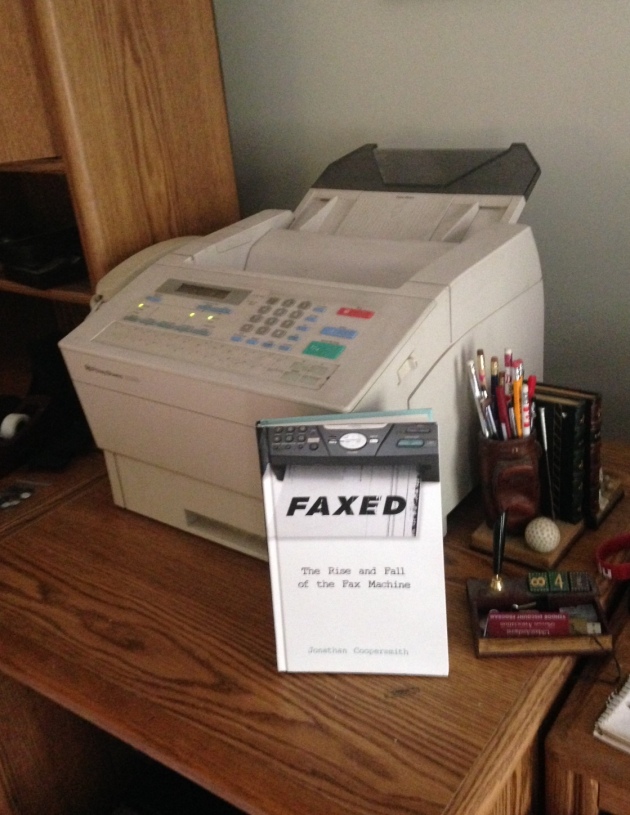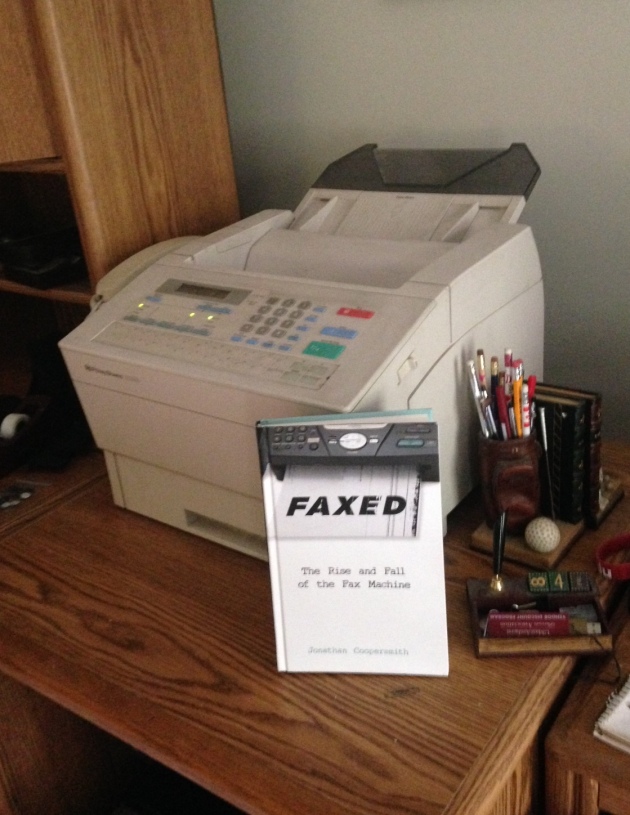Faxed: A Book Review – Ruminations
May 6, 2017 Leave a comment
In my last post, I talked about the book written by historian and professor Jonathan Coopersmith entitled Faxed – The Rise and Fall of the Fax Machine. I left off as fax entered the late Eighties and became wildly popular. As Coopersmith recounts, this confounded the experts, who were expecting electronic messaging, videotext or a variety of other technologies to supersede fax.
In my own work life, I’d worked for a fax company for a decade by then, but didn’t get close to the technology until I joined Product Line Management and wrote the business case for a fax modem product. Like many companies, Fujitsu sold fax machines, but we also started developing computer-based products. Around 1989, we released the dexNet 200 fax modem and accompanying software called PC 210 which ran on IBM compatible computers. A year later, my boss sent me to the TR-29 fax standards committee and I discovered that this group was writing standards that would have a big impact on most companies in the wild west activity known as computer fax. I also joined an upstart industry group, which became the International Computer Fax Association (ICFA) and started reporting to them on the standards being developed at TR-29. Fax was hot, but Fujitsu was focused on its mainframe computer business and shut down the US-based business called Fujitsu Imaging Systems of America (FISA) that employed me. After a month of soul searching, I decided to start a consulting business called Human Communications which advised clients on fax and related technologies. The ICFA was one of my first clients and I continued to attend TR-29 and gradually built up a client list among fax machine and computer fax companies.

By late 1993, the business was going well and that’s when I originally met Jonathan Coopersmith. In his book, he talks about this period as being the heyday of fax. Fax did extremely well in the US, as pizza parlors installed fax machines and offices of every size had one. But it became even more popular in Japan. The Japanese fax manufacturers competed fiercely, but also cooperated to ensure interworking between their machines. I started attending the meetings of ITU-T Study Group 8 in starting around this time and we were building the new extensions to the very popular Group 3 fax standard. There was a newer digital standard called Group IV, but Group 3 took on its best attributes and basically shut Group IV out of the market.
In the mid-Nineties, the Internet and the World Wide Web exploded and began a massive transformation in the way the world communicated. In the fax community, it was obvious to many of us that the Internet would have a huge impact, so we started a very aggressive effort to write Fax over IP standards. Dave Crocker, a co-author of the standard for electronic mail in the Internet Engineering Task Force (IETF), came to TR-29 and asked for volunteers to begin the work of Internet Fax in the IETF. A similar effort began in the ITU. The work proceeded from ground zero to completed standards by 1998, which was unusually fast for standards groups.
I left the fax consulting business in late 1999 and joined the Voice over IP industry. By then, there were already signs that fax would lose its dominance. The World Wide Web totally took over the information access role that had been played by Fax on Demand. The chip companies stopped focusing on fax and by the time a new version of the T.38 standard was written in 2004 to accommodate the faster V.34 modem speeds for fax over IP, the VoIP chips didn’t support it.
In Japan, as Coopersmith explains, fax had been even more dominant than in the US. The visual aspects of Japanese characters such as kanji meant that computer keyboards were much slower to develop in Japan than in the US market. By the time I met Jonathan again in 2004, fax had begun its next move and had become more of a niche business both in the US and in Japan. It still sells well in some market segments and there has been a bit of a renaissance as the T.38 fax standard has kicked in to accompany Voice over IP, but the arc of technological history is now in the long tail phase for fax.
Fax is a classic example of a technology that had many false starts — the first half of the book shows just how many there were — but eventually caught fire as all of the pieces came together for massive success. This book offers some good context on all of this and has many useful lessons learned for technologists. Great technology is never enough by itself, but when the right combination of market needs and technology come together, amazing things can happen. Faxed, the book, tells that story for fax.

Recent Comments